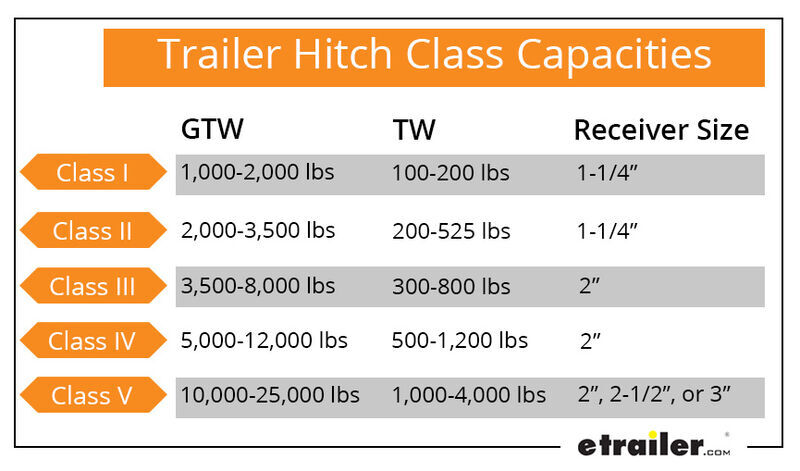
Class I hitches are perfect for smaller accessories or towing small trailers. The rear receiver hitch is by far the most common type of truck hitch.

Trailer hitches are organized by classes with each class rated to indicate its maximum towing weight capacity and tongue weight.
Different classes of trailer hitches. Class 2 hitches are quite different from class 3 hitches. Class 2 hitches have a. There are a total of 5 trailer hitch classes with Class I having the lowest capacity and Class V having the highest.
Hitch classes essentially designate the hitch opening size and weight capacity. Heres a quick breakdown of the 5 hitch classes their associated capacities and their typical receiver sizes. Okay great you may be thinking.
Trailer hitches are separated into 5 different classes. Each class is designed to accommodate different towing weights receiver size and vehicle compatibility. Class 1 Trailer Hitch A Class 1 rear-mounted hitch will have the lowest towing weight capacity of up to 2000 lbs.
And the smallest receiving tube of 1-1¼ inches for hitching. Class I hitches are perfect for smaller accessories or towing small trailers. Examples of what you can usetow.
Bike rack cargo trays small tent camper jet skis. 2 Class II Hitch. Class II hitches are also considered weight carrying hitches similar to Class I hitches but have the ability to handle more weight.
In this blog I will do an overview of each of the seven common hitch types which include. Rear Receiver Trailer Hitch. The rear receiver hitch is by far the most common type of truck hitch.
This type of trailer hitch can be used for towing a trailer along with many other uses like I mentioned above. The classic rear receiver hitch has a square. To differentiate the first class of trailer hitches is weight carrying hitches.
They let the towing vehicles rear end bear the trailers tongue weight. Weight carrying trailer hitches are generally applicable for smaller trailers and cargo. On the other hand Weight distributing hitches are for larger loads such as campers big trailers.
A Class 1 trailer hitch can handle a gross trailer weight GTW of up to 2000 lbs and a maximum tongue weight of 200 lbs. This type of hitch is often used on small cars pickups or vans for light-duty towing. Trailer hitches are organized by classes with each class rated to indicate its maximum towing weight capacity and tongue weight.
A tow hitch with a class 3 hitch rating for example has a towing capacity thats higher than a class 1 hitch. Class I hitches are weight carrying WC hitches rated up to 2000 lbs. Gross trailer weight GTW with a 200 lbs.
Maximum trailer tongue weight TW A Class I hitch usually has a 1-14 square receiver opening. A higher class ball mount does not increase the towing capacity of the hitch. You insert the trailers ball mount or another hitch-mount into the tube.
Receivers are organized into classes based on the maximum weight they can handle. Ratings range from Class 1 which can carry weight up to 2000 pounds to Class 5 which carries a maximum of 12000 pounds. At nearly 3500 lbs you can hitch a smaller trailer or boat.
Now we are into the heavy-duty section of the different hitch classes around. Hitch Class 3 puts your GTW up to a stunning 8000lbs which allow you to hitch fishing boats and larger trailers. If you are in this class then you probably have a pretty rugged vehicle.
Receiver hitches are generally grouped into three sizes and each of these corresponds to one or two towing capacity classes. Class I and Class II receiver hitches generally have 1-14 inch receivers and are suitable for pulling lighter loads up to 3500 pounds. Class III receiver hitches use 2 inch receivers and can handle medium duty towing.
A Class II hitch usually has a 1-14 square receiver opening. A higher class drawbar does not increase the towing capacity of the hitch. Class II hitches usually attach to the bumper or vehicle frame.
Class III hitches are weight carrying WC and also are weight distributing WD depending on the vehicle and hitch specifications. Cass 1 hitches work well on cars like small sedans. Class 1 hitches tow up to 2000 pounds or 907 kilograms.
They can be used to pull a trailer that is 6 feet 18 meters long or a boat that is 14 feet 43 meters long. They are good for use on smaller cars such as small sedans sports cars and compact cars. Class II hitches are capable of taking loads of 3500 lbs.
Of gross trailer weight. They can also handle a tongue weight of 300 lbs. This class is therefore ideal for a camper motorcycle trailer snowmobile trailer or small boat trailers.
The class II hitches are perfect for SUVs a full-sized pickup vehicle full-size vans and other large cars. The best hitch for travel trailers is a class 3 class 4 or class 5. These hitches offer the capacity to safely tow a variety of larger trailers particularly travel trailers.
Most of these receiver hitches are also compatible with a weight distribution hitch a device typically needed for towing travel trailers. Tow Hitch Receiver Sizes and Classes CLASS 1 CLASS 2. Class 1 and Class 2 receivers are both very similar in that they both are a 1-¼ receiver tube.
Both are designed for smaller passenger vehicles like sedans and smaller vans that are towing very lightweight trailers and loads. The weight of the trailer will press down between the cab of the truck and the rear axle. Receiver hitches are categorized in classes 1 through 5 according to the maximum amount of weight they can tow.